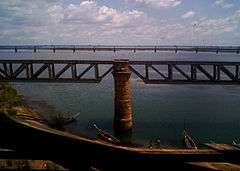Old Godavari Bridge
| Old Godavari Bridge | |
|---|---|
 Havelock Bridge on the left and Godavari Arch Bridge on the right. | |
| Coordinates | 17°00′26.6″N 81°45′21″E / 17.007389°N 81.75583°ECoordinates: 17°00′26.6″N 81°45′21″E / 17.007389°N 81.75583°E |
| Carries | Railway Line |
| Crosses | Godavari River |
| Locale | Rajahmundry, India |
| Official name | The Havelock Bridge |
| Other name(s) | Old Godavari Bridge |
| Followed by | Godavari Arch Bridge |
| Characteristics | |
| Total length | 2.7 kilometres (1.7 mi) |
| Design life | 100 years |
| History | |
| Construction start | 11 November 1897 |
| Opened | 30 August 1900 |
| Closed | 1997 |

The Old Godavari Bridge (also known as The Havelock Bridge) is a decommissioned bridge that spans the Godavari River in Andhra Pradesh, India. Commissioned in 1900, the bridge served trains plying between Howrah and Madras. It is the earliest of three bridges that span the Godavari River at Rajahmundry. The Godavari Arch Bridge was later constructed as a replacement for the Havelock Bridge.[1] The bridge along with the Godavari bridge and Godavari Arch Bridge is one of the most recognised symbols of Rajahmundry and of the state of Andhra Pradesh.
History
The construction of the bridge commenced on 11 November 1897 and opened for traffic on 30 August 1900. The Bridge was named after Sir Arthur Elibank Havelock, the then Governor of Madras. Frederick Thomas Granville Walton served as the Engineer-in-chief assisted by executive engineers R.A.Delanougerede, F.D.Couchman, J.E.Eaglesome.[2]
The bridge was constructed with stone masonry and steel girders. It has 56 spans each of 45.7 metres (150 ft)and is 3,480 metres (11,420 ft) long. The rail bridge served the busy Howrah-Chennai line until its decommissioning.
Having served its full life span of 100 years, it was decommissioned in 1997, and Godavari Arch Bridge was built as a replacement for the bridge. Today, the bridge is being used to host civic water supply pipelines.
Present status
After being planned to be converted into a national monument,[3] historic monument[4] now its finally planned to be converted into a tourist spot,[5] as a pedestrian pathway. In 2008 the Municipal Corporation of Rajahmundry passed a resolution expressing willingness to take up the beautification project.[6] With the Railways Ministry not coming forward for implementation of the project, Former Member of Parliament Vundavalli Aruna Kumar has appealed to the Railways Ministry for the approval of the project.[7][8] As of 2017 the project was still awaiting funds to commence.[9]
Sister bridges
See also
References
- ↑ R.R.Bhandari. "Bridges: The Spectacular Feat of Indian Engineering" (PDF). Retrieved 2012-07-30.
- ↑ Khan, Mukram. "The Havelock Bridge Meorial Stone | Flickr - Photo Sharing!". Flickr. Retrieved 2012-07-30.
- ↑ "Andhra Pradesh / Hyderabad News: Havelock Bridge to be a national monument". The Hindu. 26 July 2007. Retrieved 30 July 2012.
- ↑ "Rajahmundry Municipal Corporation: Introductory". Rajahmundry Municipal Corporation. 8 February 2012. Retrieved 30 July 2012.
- ↑ "Andhra Pradesh / Rajahmundry News : Havelock bridge to be developed into tourist spot". The Hindu. 18 December 2008. Retrieved 30 July 2012.
- ↑ "National / Andhra Pradesh: Fate of Havelock bridge hangs in balance". The Hindu. 16 March 2009. Retrieved 30 July 2012.
- ↑ "Andhra Pradesh / Rajahmundry News : MP's plea on Havelock Bridge". The Hindu. 24 April 2010. Retrieved 30 July 2012.
- ↑ "Need To Develop Old Godavari Bridge, Known As ... on 22 April, 2010". Lok Sabha Debates. Indian Kanoon. 22 April 2010. Archived from the original on 27 October 2014.
- ↑ Chowdhury, Arka Roy (5 December 2017). "Havelock Bridge may soon be converted into a tourist destination". Gurgaon, India: Happy Trips (Times Internet). Archived from the original on 5 December 2017.
| Wikimedia Commons has media related to Godavari Bridge. |